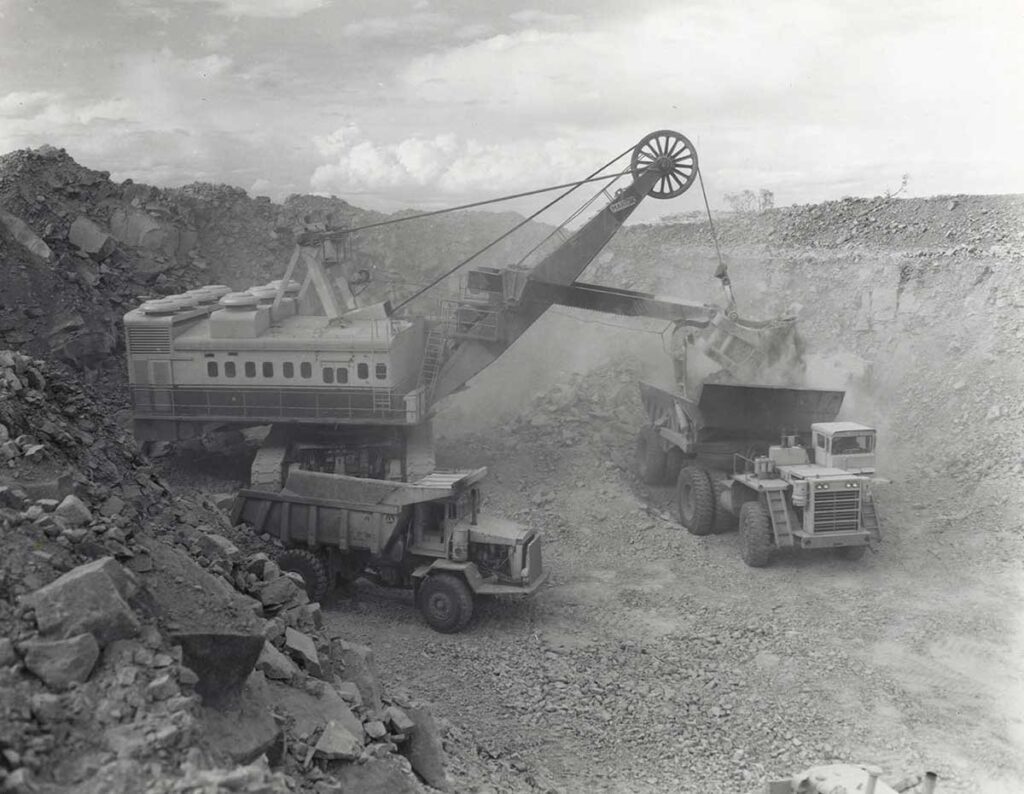On this day, 1 December 1960, the Australian Government issues the first export license for iron ore, the start of a great flood of mineral exports which greatly increased Australia’s prosperity. The Menzies Government had invested heavily in mineral and fossil fuel exploration in the 1950s, but prior to this license issue, protectionist impulses and the hangover of a war-mentality meant that Australia had hoarded her resources by upholding a ban on the export of the iron ore begun in May of 1938.
This ‘hoarder’ mentality was undoubtedly underpinned by the strategic necessities of the Cold War, and the very real fear in the early days of the Menzies Government that the world may have been on the precipice of a new global conflict. However, it may also have been influenced by Menzies’s ‘pig iron Bob’ epithet, and the flack he had taken for opposing striking workers who were trying to block the export of pig iron to Japan during the late 1930s, just after the ore ban had been instituted. As Attorney-General and Minister for Industry Menzies had insisted that the Government could not ‘go it alone’ in banning exports to Japan when the rest of the League of Nations had not, nor could it allow its foreign policy to be dictated by the strikers.
Mining exploration and expansion were a key part of Robert Menzies’s 1958 election slogan ‘Australia unlimited’. During his policy speech he listed discoveries ‘In uranium, bauxite, rich deposits of copper and other minerals, Rum Jungle, Radium Hill, Mary Kathleen, Weipa, Mt. Isa, these have become known and exciting names; they illustrate the truth that we are entering upon a dramatic phase of development’. His real hope was for a major oil discovery, and he pledged £1,000,000 per year in government funding to the search for one.
Despite this enthusiasm on the part of the Prime Minister, it took an extended lobbying campaign from people like Western Australian Premier David Brand, WA Minister for Industrial Development Charles Court, pastoralist/prospector Lang Hancock, and Federal Minister for National Development Bill Spooner to get Menzies to relax the export restrictions. The reasons for this were hesitancy in his Prime Minister’s Department and criticism from the Federal Labor Party who claimed that the restrictions were necessary for Australian manufacturing.
The easing would be somewhat gradual, initially limited to smaller or previously undiscovered deposits which would not risk Australia’s strategic reserves. By 1965 it had become clear that Australia’s deposits were far more extensive than had previously been imagined, £800 million of contracts had already been negotiated, and Menzies lifted a ban on exports from Yampi Bay – crucial for opening up northern WA. The final embargos were lifted shortly after Menzies left office in 1966.
The immediate success of the granting of export licenses, and Menzies’s desire for a diverse mining industry which went beyond iron ore, were reflected in the commitments of the 1961 election, where he promised:
· The modernisation and re-building of the Mt. Isa-Townsville-Collinsville railway for Copper Mining in North Queensland
· The mechanical improvement of coal ports at Newcastle, Balmain, Port Kembla and Gladstone
· The equipment of the Broken Hill-Port Pine railway, chiefly in South Australia, with modern rolling stock and diesel locomotives
· A standard gauge railway to be built from Kalgoorlie to Kwinana through Perth
This extensive investment, £70m in total, showed a tremendous amount of foresight. Just as Menzies had seen that Australia could not continue to rely on exports to Britain and Europe when he signed the trade agreement with Japan in 1957, he likewise saw that Australia could not hope to maintain the great wealth and living standards of the post-war boom if it remained too heavily reliant on agricultural exports. It is worth noting that Japan would initially be the major buyer of Australian iron ore, and the way in which ‘pig iron Bob’ ultimately succeeded in transforming Australia’s relationship with the old enemy is one of his greatest legacies.
Increasing trade with Australia’s neighbours also required chipping away at Australia’s deep-rooted system of protectionism. It was after all Australia’s protected manufacturing industries who were meant to use up the iron ore if war never eventuated, mining companies having to use equipment made more expensive by protective tariffs were put at a comparative disadvantage, and countries like Japan and later China could not be expected to accept Australia’s minerals if we would not accept their manufactured goods.
On the protectionist front Menzies’s attitude has always been somewhat obscured. He certainly did not invest political capital into questioning the status quo, and often bowed to pressure from the Country Party’s Jack McEwen on the issue. On the other hand, Menzies was never zealously protectionist, as he encouraged trade and frequently criticised the role of vested interests in the Australian political system. David Kemp has argued that Menzies was someone who was ‘prepared to let protection erode and come under challenge’, but who knew that for the moment a full-scale assault on it was politically impossible and premature.
Menzies was undoubtedly a gradualist, but this patience was what helped him to build achievements which would last. On the mining issue he was genuinely enthusiastic, and when the dam finally burst there would be nothing gradual about the economic transformation that was to come.
Further Reading:
‘Defining Moments: Iron Ore Exports’, National Museum of Australia, https://www.nma.gov.au/defining-moments/resources/iron-ore-exports
Peter Kennedy, ‘How Australia’s iron ore export ban was beaten’, Australian Financial Review, 10 May 2021.
David Kemp, A Liberal State: How Australians Chose Liberalism Over Socialism, 1926-1966 (Melbourne University Press, 2021)
Sign up to our newsletter
Sign up for our monthly newsletter to hear the latest news and receive information about upcoming events.


